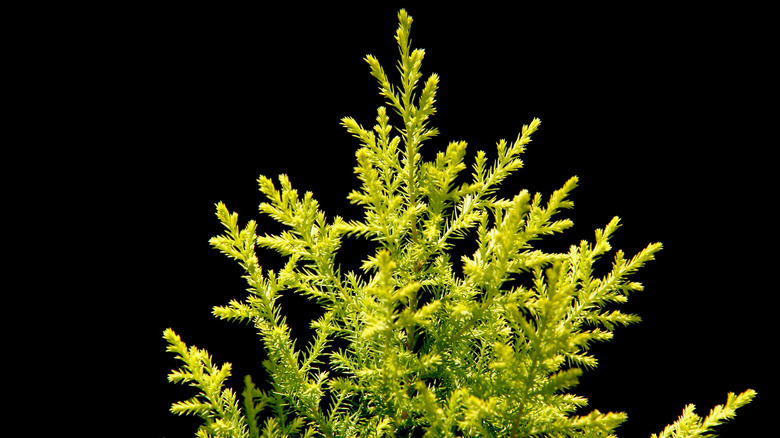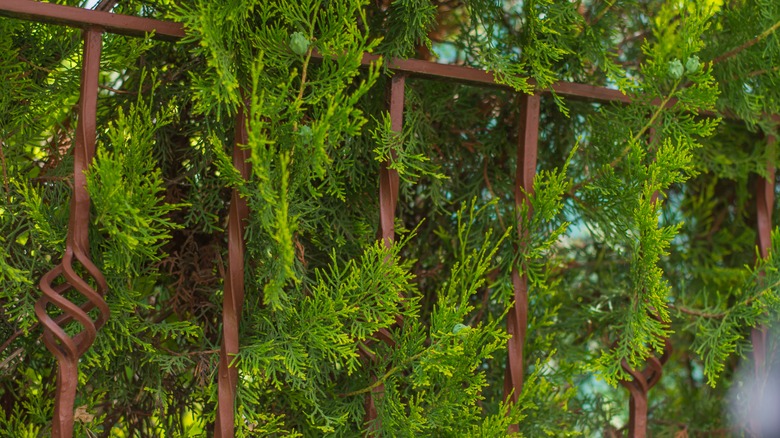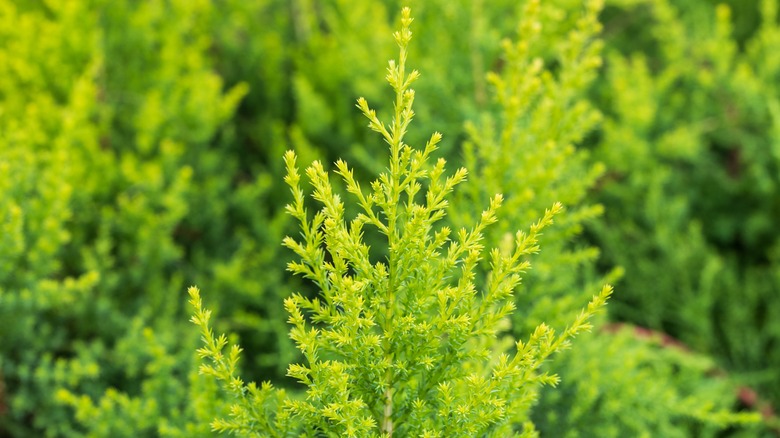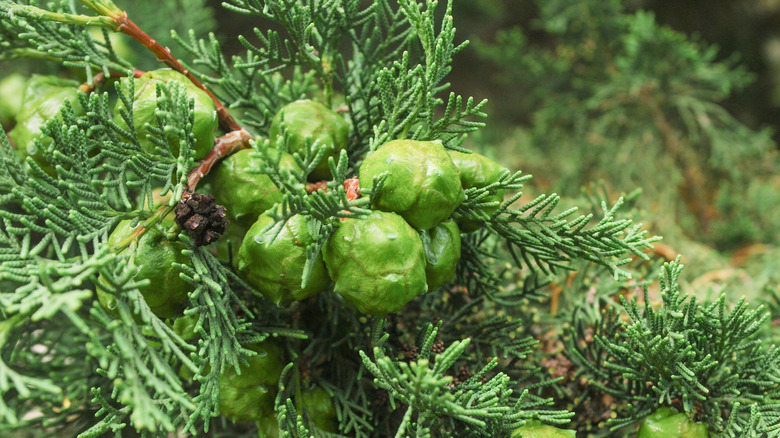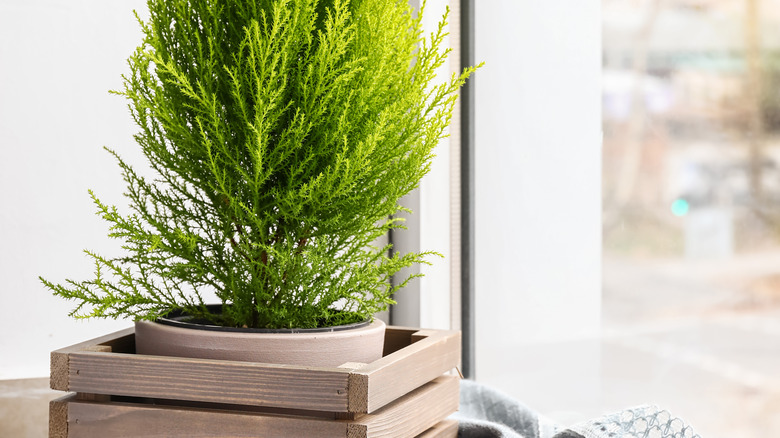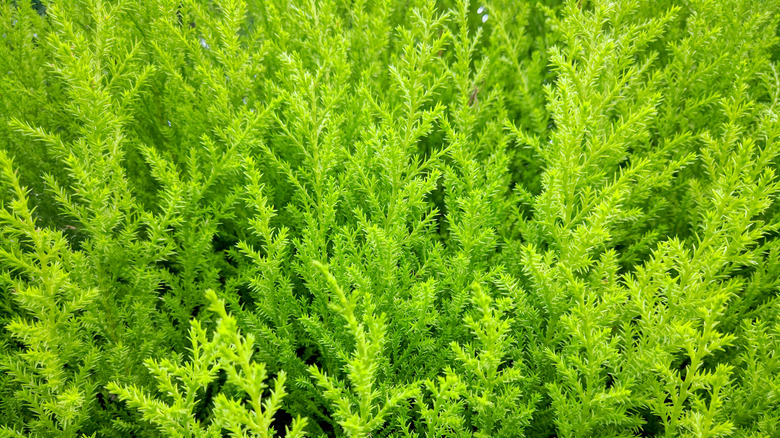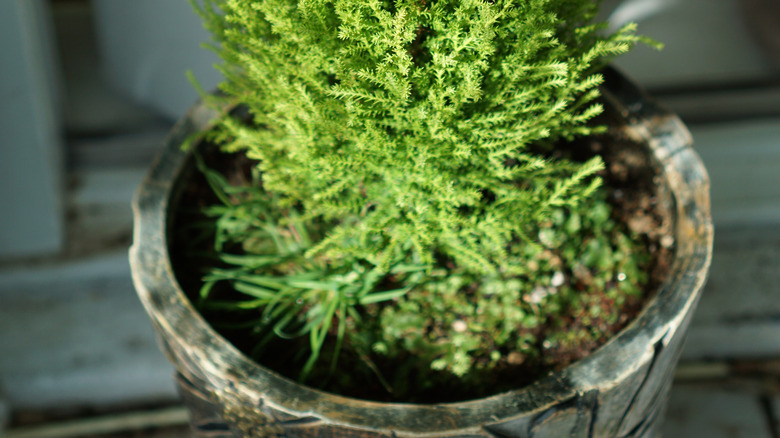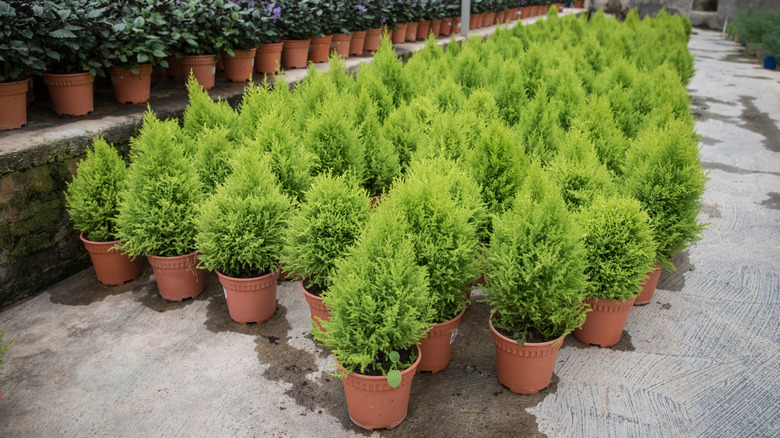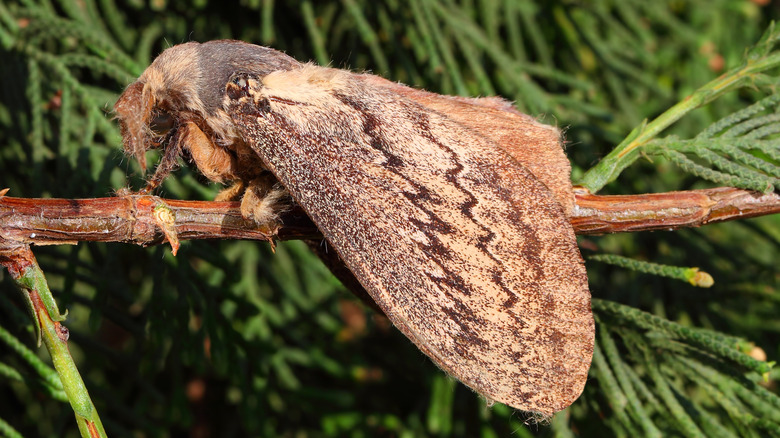Lemon Cypress Trees: Everything You Should Know Before Planting
Are you looking for an aromatic plant that can both inspire and add charm to your home or garden? Attractive and boisterous, cypress trees have been delighting us for ages with their picturesque greenery. From towering columns to petite, dwarf planters, cypress trees possess a lovely stature and are easily adaptable in several parts of the United States and Europe. Of the many cypress tree varieties, the lemon cypress (Cupressus macrocarpa) is a classic presentation of the coniferous evergreen tree, as noted by Better Homes & Gardens.
A California native, the lemon cypress has many aliases: Monterey cypress, "Goldcrest Wilma," and lemon cedar. Often displayed during the holiday season, lemon cypress trees are a household staple. With spikey, needle-like foliage and chartreuse, Grinch-green color, this decorative shrub is coniferous, as it utilizes small, sphere-shaped cones to function as its method of procreation.
What makes them so unique? They emit a fresh, lemon citrus fragrance when caressed or crushed in your hands. Charming in size, dwarf lemon cypress trees generally grow only up to 3 feet tall. If planted outside, they can reach up to 16 feet or more. According to The Spruce, C. macrocarpa "Goldcrest" is available in any season and can be used as a hedge, potted plant, topiary, or even bonsai. If you're thinking about planting a lemon cypress tree, read on to learn everything there is to know before you start!
How to use lemon cypress trees in gardens
Lemon cypress is a diverse evergreen tree. Big or small, this friendly plant is welcoming when placed alongside your walkway or in window boxes. If you desire more privacy on your property, utilize "Goldcrest" with a hedge line or showcase it as a focal point in the front or backyard. Whatever you envision, these delightful shrubs will increase the aesthetics of your landscape.
When planted outside, be sure to place your lemon cypress tree where the sun reaches it the most, provided with partial shade; it won't last long in a complete veil. Gardening Know How suggests getting the plant into the earth while the soil increases in temperature in spring. Doing so will provide the new system of roots with ample time to grow prior to the onset of winter.
Lemon cypress trees should always be protected during a freeze. As winter comes, plan to repot or place your outdoor "Goldcrest" inside, as it easily transforms into a beloved houseplant. Lemon cypress plants won't stand a chance outside in winter, as temperatures below freezing will not preserve them.
How to grow lemon cypress trees
Available all year round, growing lemon cypress trees is a fairly low-maintenance process. An initial factor is determining which USDA plant hardiness zone you inhabit. According to Gardening Know How, it's important to determine this detail to support your lemon cypress tree's longevity, as it flourishes in zones 7 through 10.
Next, visualize the best location for your lemon cypress tree. Indoors or outdoors? It will be happy in either environment, as lemon cypress is undoubtedly compliant. Wherever you decide, your top priority should be to provide it with plenty of sunlight and water.
What kind of pot should you use? This depends on its size and your preference. Lemon cypress trees will be content placed in a pot, vase, or other sizeable containers. Additionally, they're not particular about the type of garden soil used if it is well-drained. Decorate it with white rocks or river stones on top.
How to grow lemon cypress trees from seeds
As shown above, the seed pods of a lemon cypress tree start green, then dry out, become brown, and crack open. Once they break open, you can remove the smaller seeds and plant them as new trees. It's best to start seeds in small grow pots instead of sowing them directly into the ground. Use a loamy potting mix in your starter pot and simply set the seeds on top of the soil; they do not need to be packed down. Dave's Garden suggests covering them with a layer of wet newspaper to retain moisture. It's important that the grow pots are given a sunny spot for germination, but it's equally important to keep everything evenly and consistently moist.
Lemon cypress tree seeds can germinate for up to three months, so patience will be key as you wait to see the sprouts appear above the soil. It will be a year before the seedling is large and strong enough to be transplanted outside. As it continues to grow, you may find yourself in need of a larger container. When you repot it, do what you can to reduce transplant shock; water your seedling before moving it, set up its new pot with the same type of growing medium, and work quickly yet gently to minimize root disturbance. After a year of growth, your little tree can go into the ground. Dave's Garden advises that the proper hole size will be neither deep nor shallow. You want to just cover the roots up to the point where the trunk shoots out.
How to care for lemon cypress trees
When it comes to lemon cypress trees, remember these three things: sun, soil, and water. If you decide to place lemon cypress trees indoors, place them where they will receive at least six to eight hours of sunlight each day. Laura LeBoutillier of Garden Answer suggests placing them near windows so they can take in plenty of sunshine while maintaining their average indoor temperature of approximately 60 degrees (during winter months). If they don't get enough light, they will dwindle and darken.
Also, regulate their water intake by keeping the soil moist; a couple of waterings per week during their initial growth season is ideal. Regarding watering your lemon cypress, LeBoutillier also notes to keep the soil "not too soggy or wet and not ever dried out." Feel the surface of the dirt to determine its moisture level.
Maintenance for lemon cypress hedges or bonsai trees is generally required, yet light annual pruning is a good idea. The color may tone down with time, so Leboutillier recommends "shaping the tips," even every couple of weeks. You can also remove any dead parts of the plant, then cut the branches to acquire a shape if desired. This will encourage its growth and retain the plant's vitality.
Varieties of lemon cypress trees
Lemon cypress trees originate from their cultivar, the Monterey cypress. Monterey cypress trees differ in appearance, according to Leafy Place, but the aromatic scent and the flexible soil conditions remain. Monterey cypress is a large, majestic tree with a fibrous bark that peels away as the tree develops. Their spiny, bonsai-like frames give them character as they often overlook the California coastline. On average, they grow tall, between 40 to 70 feet, reaching up to 130 feet.
The most common version of the lemon cypress tree is the dwarf tree; it enlightens most indoor spaces while sitting in a quaint container. Another type is Japan's dwarf Hinoki cypress, per The Spruce. With similar needs to the lemon cypress tree, this petite planter thrives in humidity and is suited for USDA zones 5 through 8. Weekly watering and low-maintenance pruning are all that are needed. Finally, you'll see other varieties of cypress trees residing in parks or large yards, as they are too large to grow in home gardens.
Are lemon cypress trees toxic?
Cypress trees are listed as non-toxic by California Poison Control. Lemon cypress is a cherished houseplant for this reason, making it both kid and pet friendly. Cats and dogs won't be bothered by the lemony scent either, but depending upon the animal, be mindful of them potentially eating the small cones.
Although lemon cypress is considered non-poisonous inside the home, it's important to note that most cypresses are not edible, according to SFGate. Still, some trees are considered edible within the cypress family, including the medicinal summer cypress.
Experts at Gardenerdy agree that people with sensitive skin should be careful when touching the lemon cypress's foliage, as it may cause some skin irritation for those with sensitive skin. Overall, it's a good idea to avoid consuming the foliage of any cypress tree plant. As everyone reacts to things differently, it's good to be cautious with this type of foliage.
How to repot lemon cypress trees
Once your lemon cypress tree roots are established, or perhaps if the soil dries out too often, it may be ready to move into a larger container, says TopiaryTree. Again, regulate its water intake. According to Gardening Know How, it is not wise to "winterize" a lemon cypress tree; a good time of year to repot is just before the winter. Laura LeBoutillier of Garden Answer likes to repot her lemon cypress every few years while using an organic potting mix. As they grow, she circulates them with ease from outdoor to indoor and vice-versa. Regarding fertilizer, once in the spring should be fine.
Depending upon your location and soil conditions, fertilizer is not much of a concern for lemon cypress. According to The Spruce, these hardy trees are accustomed to soil conditions that are less than ideal. To that end, too-rich soil will cause uneven growth and cause lemon cypress trees to look unbalanced. Keep the soil damp regularly.
How to propagate lemon cypress trees
Cuttings can be taken from a mature tree in springtime when the needles have lost any reddish tint, says AzFlora on their YouTube channel. The first cutting should be at least 6 inches long, taken from a healthy branch. Moving from the bottom up, use a sharp knife to slice downward at each leaf juncture so that each cutting retains some of the initial branch. Place them in a bowl of water as you go to keep them hydrated.
Next, remove your cuttings from the water. Line them up so the cuts face down and dip them into a liquid or powder rooting hormone. Afterward, they will be ready to plant in a pre-moistened potting mix. Use your finger, a pen, or something similar to make narrow holes in the soil, then slide a single cutting into each hole. It's fine to plant multiple cuttings next to each other in the same grow pot.
AZFlora creates miniature greenhouses by first lining a tray with pine bark and adding water. Next, they position the grow pots on top of the bark chips. Finally, they take a large, empty water bottle and cut the bottom off it. Leaving the cap secure at the top, they slide one of these makeshift plastic coverings over each grow pot. The plastic retains heat and moisture, and the space created by the bark chips underneath the grow pots allows the seedlings to be watered from the bottom by refilling the tray. By autumn, your cuttings should become rooted, which means they're ready to be transplanted into larger containers or the ground.
Pests and plant diseases to watch out for
Generally speaking, lemon cypress trees fare best when grown near the coastline. Inland trees become susceptible to a fungus known commonly as cypress canker or coryneum canker, per the University of California Agriculture and Resources Department. At first, you might see resin deposits on the bark. Branches and treetops will turn a brownish yellow color as it succumbs to the infection, which can be lethal. Another sign of infection is the appearance of cypress bark moths, which lay eggs in these cankers. It's possible that the larvae can kill off individual tree branches simply from feeding. However, it's the fungal infection that ultimately does in the whole tree.
Per the University of Arizona College of Agriculture and Life Sciences, cypress bark beetles can be hazardous to a tree already suffering from drought damage. They bore into twigs along the branches until they were hollow and fell off. As the beetles lay eggs and multiply, they have the potential to hurt a tree by stifling the flow of nutrients.
Pesticides are not recommended for either the moths or the beetles. Instead, proper care and tree health maintenance best prevent infestations. Furthermore, be careful not to over-fertilize or water. Both of these stimulate rapid growth, which results in a thinner bark that is particularly attractive to females looking for a place to lay their eggs.
